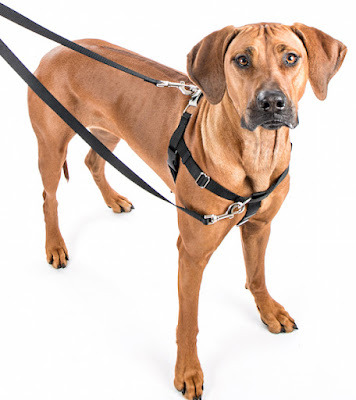At one time or another, most owners have encountered a dog that likes to pull hard on the lead, rushing off on that daily walk and dragging them along at a rate of knots.
If this sounds familiar and you'd like to rectify this behaviour there are a few things to consider before you buy a walking aid of any description.
A lot of dogs will pull on a lead for two main reasons. Firstly, their arousal and excitement are heightened when they go for a walk. As soon as they get out of the door, they are greeted with an abundance of smells and they are very keen to explore.
Secondly, a dog will probably pull more on a lead because they want to achieve equilibrium. Basically, there is a pulling sensation on the lead to bring them back and they just pull harder to go in the direction they want to go.

One solution for a dog that is a little over enthusiastic is to get a no pull dog harness. This can be a fairly sturdy harness that fits over the chest and torso and has a number of useful features.
· An attachment for the lead in the usual place between the dog's shoulder blades
· Another attachment at the front of the harness for training your dog to walk beside you
· A short handle on the back of the harness that helps you manage difficult situations such as when you are bothered by another dog or if you are getting into a car.
The front attachment is the key to how the harness works. If you attach a lead to this metal ring, your dog will be corrected in a side to side motion and not a front to back motion. This means that they won't feel the need to create that equilibrium because any pulling or straying will be halted by pulling them into you rather than pulling them back to you.
Training your dog to walk 'properly' and not pull on the harness can take time and a good deal of patience, depending on the personality and size of the animal. It's important to have some rewards when your dog walks calmly to heel and to pull back on the harness firmly but gently, with an accompanying command when it begins to forget you are there and starts surging forward.
You should be using the harness to stop your dog pulling from the moment you put it on and start out on that first walk. That way it gets to equate the no pull dog harness with walking correctly whilst it is out with you.
Here are a few more tips for encouraging your dog not to pull on the lead:
For your first few times out with the no pull harness make sure you choose a time when there will be few distractions for the dog so that you can concentrate on the behaviour to be corrected.
Don't tug too hard on the harness - keep it firm and give a command when you do so.
Keep the leash shorter than normal but never too tight
Allowing your dog to pull reinforces the pulling behaviour so it makes sense to be committed to getting it to walk politely and calmly beside you.
Try some concerted operant conditioning, which simply means that you reward your dog for good behaviours until that behaviour is ingrained enough not to require a reward at all. This can be a little doggy treat or simply giving your dog a scratch behind the ear and a bit of fuss.
Above all, find what works for your dog. Just like humans, dogs have their own personalities and peculiarities. What works for one may not have any effect on another. For example, some trainers recommend coming to a stop when the dog begins to pull on the leash and waiting until it returns to your side though there are plenty of owners who will attest that this doesn't work at all.
Getting the right no pull dog harness for your dog is as important as devoting yourself to the training. You need to get something that is comfortable and sturdy and which is easy to put on and take off. If you are going out at night with the dog, then a harness with reflective patches or strips is also important if you want to stay safe and be seen at all times.
Source: http://ezinearticles.com/?How-Do-No-Pull-Dog-Harnesses-Work?&id=9271665





No comments:
Post a Comment